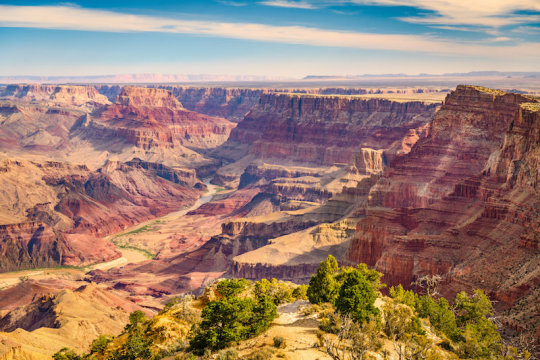[ad_1]
Earth’s outer layer is composed of giant plates that grind together, sliding past or dipping beneath one another, giving rise to earthquakes and volcanoes. These plates also separate at undersea mountain ridges, where molten rock spreads from the centers of ocean basins.
But this was not always the case. Early in Earth’s history, the planet was covered by a single shell dotted with volcanoes — much like the surface of Venus today. As Earth cooled, this shell began to fold and crack, eventually creating Earth’s system of plate tectonics.
According to new research, the transition to plate tectonics started with the help of lubricating sediments, scraped by glaciers from the slopes of Earth’s first continents. As these sediments collected along the world’s young coastlines, they helped to accelerate the motion of newly formed subduction faults, where a thinner oceanic plate dips beneath a thicker continental plate.
The new study, published June 6, 2019 in the journal Nature, is the first to suggest a role for sediments in the emergence and evolution of global plate tectonics. Michael Brown, a professor of geology at the University of Maryland, co-authored the research paper with Stephan Sobolev, a professor of geodynamics at the GFZ German Research Centre for Geosciences in Potsdam.
The findings suggest that sediment lubrication controls the rate at which Earth’s crust grinds and churns. Sobolev and Brown found that two major periods of worldwide glaciation, which resulted in massive deposits of glacier-scrubbed sediment, each likely caused a subsequent boost in the global rate of plate tectonics.
The most recent such episode followed the “snowball Earth” that ended sometime around 635 million years ago, resulting in Earth’s modern plate tectonic system.
“Earth hasn’t always had plate tectonics and it hasn’t always progressed at the same pace,” Brown said. “It’s gone through at least two periods of acceleration. There’s evidence to suggest that tectonics also slowed to a relative crawl for nearly a billion years. In each case, we found a connection with the relative abundance — or scarcity — of glacial sediments.”
Just as a machine needs grease to keep its parts moving freely, plate tectonics operates more efficiently with lubrication. While it may be hard to confuse the gritty consistency of clay, silt, sand and gravel with a slippery grease, the effect is largely the same at the continental scale, in the ocean trenches where tectonic plates meet.
“The same dynamic exists when drilling Earth’s crust. You have to use mud — a very fine clay mixed with water or oil — because water or oil alone won’t work as well,” Brown said. “The mud particles help reduce friction on the drill bit. Our results suggest that tectonic plates also need this type of lubrication to keep moving.”
Previous research on the western coast of South America was the first to identify a relationship between sediment lubrication and friction along a subduction fault. Off the coast of northern Chile, a relative lack of sediment in the fault trench creates high friction as the oceanic Nazca plate dips beneath the continental South America plate. This friction helped to push the highest peaks of the central Andes Mountains skyward as the continental plate squashed and deformed.
In contrast, further south there is a higher sediment load in the trench, resulting in less friction. This caused less deformation of the continental plate and, consequently, created smaller mountain peaks. But these findings were limited to one geographic area.
For their study, Sobolev and Brown used a geodynamic model of plate tectonics to simulate the effect of sediment lubrication on the rate of subduction. To verify their hypothesis, they checked for correlations between known periods of widespread glaciation and previously published data that indicate the presence of continental sediment in the oceans and trenches. For this step, Sobolev and Brown relied on two primary lines of evidence: the chemical signature of the influence of continental sediments on the chemistry of the oceans and indicators of sediment contamination in subduction-related volcanoes, much like those that make up today’s “ring of fire” around the Pacific Ocean.
According to Sobolev and Brown’s analysis, plate tectonics likely emerged on Earth between 3 and 2.5 billion years ago, around the time when Earth’s first continents began to form. This time frame also coincides with the planet’s first continental glaciation.
A major boost in plate tectonics then occurred between 2.2 to 1.8 billion years ago, following another global ice age that scrubbed massive amounts of sediments into the fault trenches at the edges of the continents.
The next billion years, from 1.75 billion to 750 million years ago, saw a global reduction in the rate of plate tectonics. This stage of Earth’s history was so sedate, comparatively speaking, that it earned the nickname “the boring billion” among geologists.
Later, following the global “snowball Earth” glaciation that ended roughly 635 million years ago, the largest surface erosion event in Earth’s history may have scrubbed more than a vertical mile of thickness from the surface of the continents. According to Sobolev and Brown, when these sediments reached the oceans, they kick-started the modern phase of active plate tectonics.
[ad_2]















